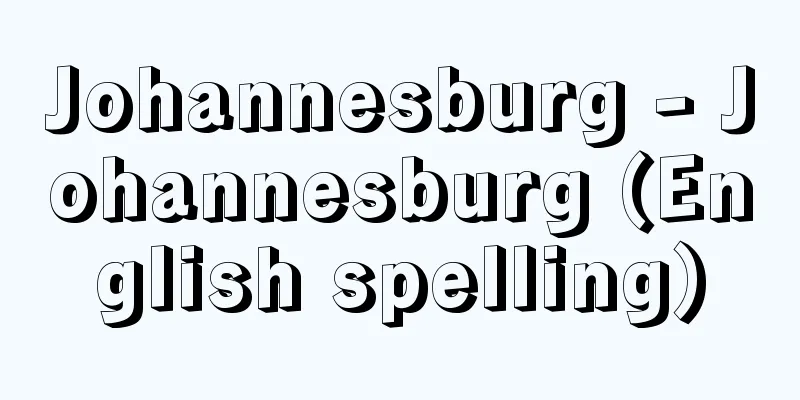Johannesburg - Johannesburg (English spelling)

|
A city in the northeastern part of South Africa, in the center of Gauteng Province (formerly Transvaal Province). It is also called Johannesburg. It is located almost in the center of the Witwatersrand Plateau, on the southern slope. It has a population of 1,480,530 (1996 census), 1,617,900 (2001 estimate). It is the largest city in the country and the capital of Gauteng Province. Located at an altitude of 1,750 meters, it has a dry highland climate, and snowfall can occur in July and August. As symbolized by the endless slag heaps that surround it, it is known as a mining city that influences the world gold market. It is also the industrial center of South Africa, with the steel, machinery, chemical, textile, and leather industries well developed. It is also the commercial center of the country, and occupies the position of the economic capital. The town's origins date back to 1886, when rich gold deposits were discovered in the Witwatersrand. A gold rush immediately ensued, and a settlement called Landsjeslaagte emerged. As more and more gold deposits were discovered, the settlement expanded to become a town, and was renamed Johannesburg. There are three theories about the origin of the town's name: Surveyor-General Johann Lissick; Transvaal politician Christian Johannes Joubert; and military officer Johannes Petro Meyer. Initially, all supplies needed for mining were transported by ox wagon from the ports of Durban and Cape Town. However, a railway line was completed from Cape Town in 1892, and from Durban in 1895, and the transportation of supplies increased significantly. This led to further growth in the town, and the population, which was 3,000 in 1887, reached 120,000 by 1899. The Transvaal was originally a republic founded by the Boers (Dutch immigrants), but the British, who had their eye on the country's rich gold deposits, started the Second Boer War (1899-1902) on the pretext of the demand for voting rights for British citizens in the country. In June 1900, Johannesburg, the country's capital, was occupied by British troops. After the formation of the South African Federation, the administrative center was moved to Pretoria, but the Chamber of Mines and the railway headquarters were left in Johannesburg, forming the basis for the city's subsequent development. In 1904, a town council was established by election, and after the establishment of the Union of South Africa (1910), cityhood was implemented in 1928. During this time, the Rand strike, the largest strike in the history of South African mining, occurred in 1922, but Prime Minister Smuts imposed martial law and brought in the military to put down the strike. In the 1930s, manufacturing developed centered around mining-related industries, and after World War II, industrialization progressed further with the influx of European and American capital, leading to a decrease in dependence on gold mines. The city center is located south of the train station, where the streets are arranged in an orderly grid pattern, with Market Street, Commissioner Street, and Fox Street running east to west, and Risik Street, Joubert Street, and Elof Street running north to south. The city hall, library (with Afrikaner Museum and Geology Museum), stock exchange, mining chamber, general post office, and South African Broadcasting Corporation headquarters are located here, as well as many corporate headquarters of mining companies and hotels. The city area was originally a land with few trees, but greening has been promoted and it is now blessed with large trees. There are many parks and cultural facilities, such as the city art museum in Joubert Park northeast of the station, Milner Park and the University of Witwatersrand in the northwestern suburbs, and H. Stein Park with a zoo and lake and the War Memorial Museum further north. However, these well-developed environments were created for white people, so to speak, and black people were segregated in Soweto (southwest residential area) in the southwestern suburbs. Soweto is a large settlement of small houses, with a standard of housing exceeding that of slum-like black townships in other cities, but with few urban facilities. With the repeal of the Group Areas Act in 1991, the townships were abolished and the area was incorporated into the administrative district of Transvaal Province (since 1993, Gauteng Province). [Akifumi Hayashi] [References] | | | |Source: Shogakukan Encyclopedia Nipponica About Encyclopedia Nipponica Information | Legend |
|
南アフリカ共和国北東部、ハウテン州(旧トランスバール州)中央部の都市。ヨハネスブルグともいう。ウィトワーテルスランド台地のほぼ中央部、南斜面に位置する。人口148万0530(1996センサス)、161万7900(2001推計)。同国最大の都市で、ハウテン州の州都。標高1750メートルの地点にあるため、気候は乾燥した高地性気候で、7、8月には降雪をみることもある。周囲に延々と連なるぼた山が象徴するように、世界の金市場を左右する鉱業都市として知られる。また南アフリカ共和国における工業の中心地でもあり、鉄鋼、機械、化学、繊維、皮革工業などが発達する。商業面でも同国の中心をなし、経済的な首都の位置を占めている。 町の起源は1886年、ウィトワーテルスランドに金の富鉱が発見されたことに始まる。ただちにゴールド・ラッシュが起こり、ランシェスラーフテという集落が出現した。金鉱脈は次々と発見され、集落は拡大して町となり、ヨハネスバーグと改称された。この町名の由来に関しては、測量長官ヨハン・リシック説、トランスバール共和国の政治家クリスチャン・ヨハネス・ジューベルト説、軍人ヨハネス・ペトロ・マイヤー説の3説がある。当初、鉱山採掘に必要な物資は、すべてダーバンやケープ・タウンの港からオックス・ワゴン(幌(ほろ)牛車)によって運ばれていた。しかし1892年にはケープ・タウンからの鉄道が、1895年にはダーバンからの鉄道が完成し、物資輸送は大幅に増加した。これにより町はさらに成長し、1887年3000人であった人口は、1899年には12万人に達した。トランスバールは元来ブーア人(オランダ系移民)が建国した共和国であったが、金の富鉱に目をつけたイギリスは、同国のイギリス人の選挙権要求を口実に、第二次ブーア戦争(1899~1902)を起こした。そして1900年6月、同国の首都であったヨハネスバーグはイギリス軍に占領された。南ア連邦結成後、行政の中心はプレトリアに移されたが、鉱山会議所や鉄道本社はそのままヨハネスバーグに残され、その後の発展の基礎となった。1904年、選挙によってタウン・カウンシル(町議会)が発足し、南アフリカ連邦成立(1910)を経て、28年市制が施行された。この間1922年、南アフリカ鉱山史上最大のストライキであったラント争議が起こったが、首相スマッツは戒厳令を敷き、軍隊を導入してこれを鎮圧した。30年代には鉱業関連産業を中心に製造業が発展し、第二次世界大戦後は欧米の資本流入とともに工業化はいっそう進み、金鉱への依存度を低くするに至っている。 市の中心は鉄道駅の南側、街路が碁盤目状に整然と並んだ所で、東西に走るマーケット通り、コミッショナー通り、フォックス通り、南北に走るリシック通り、ジューベルト通り、エロフ通りなどからなる。ここには市庁舎、図書館(アフリカーナー博物館と地質学博物館を併設)、株式取引所、鉱山会議所、中央郵便局、南アフリカ放送局本部などがあり、鉱山会社などの企業本社やホテルなどが多数並んでいる。市域は元来樹木の乏しい土地であるが、緑化が進められ、大きな木々に恵まれている。公園や文化施設も多く、駅の北東のジューベルト公園内には市営美術館があり、北西郊外にはミルナー公園、ウィトワーテルスランド大学、さらにその北には動物園や湖のあるH・スタイン公園、戦争記念博物館がある。しかしながらこれらの整った環境はいわば白人のためにつくられてきたもので、黒人は南西郊外のソウェト(南西居住区)に隔離されていた。ソウェトは小さな家屋からなる巨大な集落で、住居の水準は他の都市のスラム的な黒人居住区(タウンシップ)を超えてはいるが都市施設は少ない。1991年の集団地域法の廃止により、タウンシップも廃止され、トランスバール州(93年以降ハウテン州)の行政区に組み込まれた。 [林 晃史] [参照項目] | | | |出典 小学館 日本大百科全書(ニッポニカ)日本大百科全書(ニッポニカ)について 情報 | 凡例 |
<<: The Gospel According to John
>>: Johannes [XXIII] - Johannes
Recommend
Storm window - Storm window
…Before the performance of Okina, an altar is set...
Ohiroshikiban - Ohiroshikiban
The title of a job in the Edo Shogunate. An offici...
Euēnos (English spelling) Euenos
…The representative sophists of the time were Pro...
Botebote tea - Botebote tea
A local dish from the Matsue region of Shimane Pr...
libertin
...Broadly speaking, it refers to those who seek ...
normal strain
…( d - d 0 )/ d 0 is called the transverse strain...
Tsumatorisou - Tsumatorisou
A perennial plant of the Primulaceae family (APG ...
Crown
…He became embroiled in political struggles in hi...
Clyde Kluckhohn
American cultural anthropologist. He conducted lo...
Land register - Tochigi Prefecture
A book that clarifies the status of land and recor...
Wahneinfall
…Primary delusions are further divided into delus...
caving
Caving is a sport that involves exploring caves, u...
geomorphic cycle
...If this is uplifted, it will reach a higher le...
Obiki - Obihiki
〘Noun〙① Several people take out their obi, write t...
The Huguenot Wars
A religious war that took place in France from 15...









